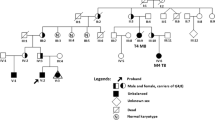Abstract.
Chromosome translocations have been known to affect disjunction of chromosomes unrelated to the translocation in the mouse and in Drosophila. However, in humans, an interchromosomal effect in chromosome translocations has not been demonstrated. The availability of techniques that allow the study of nondisjunction in sperm cells has permitted us to evaluate the possibility of an interchromosomal effect in male translocation heterozygotes. In this study, multicolor fluorescence in situ hybridization was used to determine levels of disomy for the clinically relevant chromosomes X, Y, 13, 18, and 21 in 332,858 spermatozoa from nine reciprocal translocation heterozygotes and nine controls with normal karyotypes. The specific translocations studied were as follows: t(10;12)(p26.1;p13.3), t(2;18)(p21;q11.2), t(3;19)(p25;q12), t(5;8)(q33;q13), t(11;22)(q23;q11), t(3;4)(p25;p16), t(8;9)(q24.2;q32), t(10;18)(q24.1;p11.2), and t(4;10)(q33;p12.2). Comparisons of disomy rates between carriers and controls were performed by using the Mann-Whitney test. Our results showed that the rates of sex chromosome hyperhaploidy were similar in controls (0.21%) and in translocation carriers (0.19%). Similarly, the frequencies of disomy for chromosomes 13, 18, and 21 did not differ significantly between controls and carriers (0.05% versus 0.08%, 0.07% versus 0.03%, and 0.14% versus 0.20%, respectively). Sex chromosome nondisjunction was more common than nondisjunction of chromosomes 13 and 18 both in controls (P=0.0057) and in carriers (P=0.0008). Similarly, the rates of chromosome disomy for chromosome 21 were higher than those for chromosomes 13 and 18 in both controls (P=0.0031) and translocation carriers (P=0.0057). In our study, the excess of chromosome 21 disomy versus disomy of the other autosomes was more pronounced in carriers than in controls. Thus, although the difference of disomy 21 between controls and carriers was not statistically significant, it is worthy of attention.
Similar content being viewed by others
Author information
Authors and Affiliations
Additional information
Electronic Publication
Rights and permissions
About this article
Cite this article
Estop, A., Cieply, K., Munne, S. et al. Is there an interchromosomal effect in reciprocal translocation carriers? Sperm FISH studies. Hum Genet 106, 517–524 (2000). https://doi.org/10.1007/s004390000275
Received:
Accepted:
Published:
Issue Date:
DOI: https://doi.org/10.1007/s004390000275




